My woodland has so many naturally occurring mushrooms that I am again inspired to grow my own mushrooms. I say again because when I first purchased the woodland it had no access road and I had to cut down a number of trees including oak trees to gain access to the interior where my tractor building now stands. At the time, I cut the trunk of one of the oak trees into 3ft logs and drilled and inserted shiitake mushroom plug spawn and placed the logs in a valley on the north side of a rise where it was mostly sheltered from the sun. With time the logs sprouted mushrooms, especially prolifically after extended rainy periods. Unfortunately I did not visit the site very often and when I did the mushrooms had either been eaten by wild animals or had matured and spoiled. Below is a ‘photo from April 2009 showing some overmatured mushrooms:
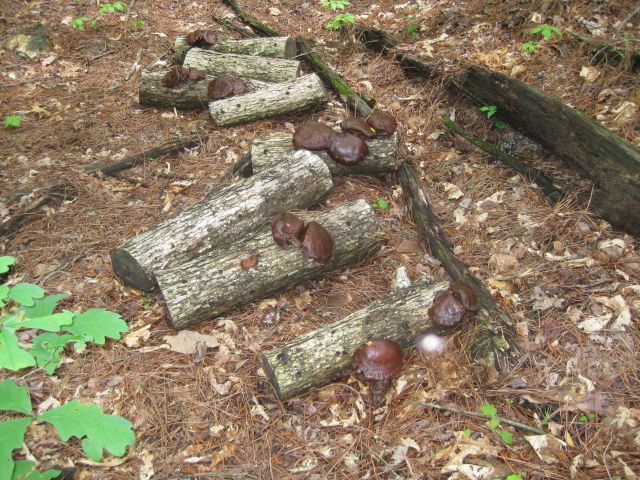
I kept myself busy with other matters and I only thought of mushrooms again last year when several wild cherry and maple trees had to be taken down. I thought mushroom growing was easy and, without research, decided to purchase several varieties of mushroom on birch dowel sticks (plug spawn) and innoculate the wild cherry logs. Bad idea! As I have now learned, cherry is not a preferred wood for mushrooms. I would have been better off using the maple logs. Apparently fruit trees, and wild cherry belongs to that class, should not be used. I built a mushroom shelter and watered the cherry logs intermittently and, to date, zero.
When my neighbor had her sound maple tree cut down (it was threatening the foundation of her house), I decided to get back in the mushroom business and bought grey dove grain oyster spawn. Grain spawn is more difficult to insert into a log than sawdust or plug spawn. Another difficulty – the logs were large in diameter, much more than the 8″ preferred diameter. So I had to make do and drilled vertical holes about a foot long into the face of the logs and filled with the spawn. Not a method I have seen used elsewhere, or recommended.
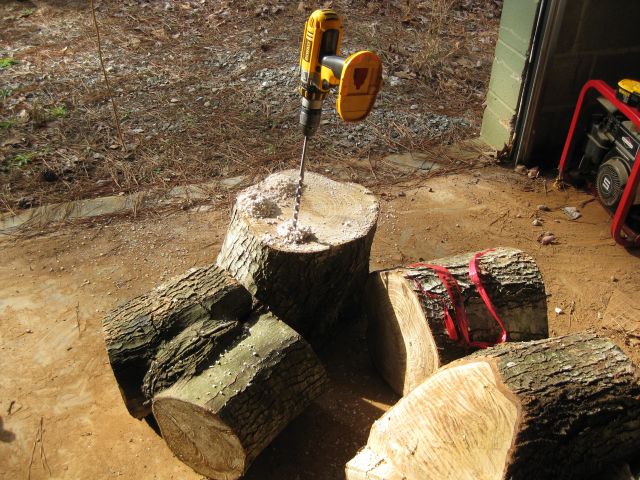
I then sealed the holes with wax – I melted the wax with a blow torch and dripped the molten wax into the holes. I tried to keep things reasonably clean and swabbed tools and materials with hydrogen peroxide – the bottle can be seen on the side of the log.
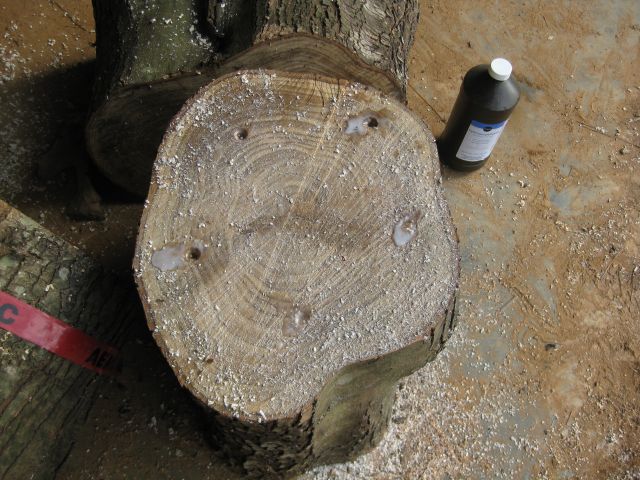
It is interesting how we draw conclusions which are so often wrong. I transferred to the wood shelter 6 of the oak logs from 2008/2009 which had borne shiitake. Four of the logs were light and two were heavy and, I assumed that if the shiitake were to fruit again (seemed unlikely after 4 years of neglect) it would do so on the heavier logs, which had more material remaining. So I placed the 2 heavier logs in the shelter where they enjoyed the same watering routine as the other logs and left the 4 lighter logs under the drip line of the roof. Well – young mushrooms began appearing on the lighter logs and not on the logs in the shelter. Perhaps the logs under the drip line received more water than the logs in the shelter, or the logs were lighter because the mycelium in those logs was more aggressive than the mycelium in the heavier logs. The logs came from the same tree so the wood should not be a factor. Below is a ‘photo of the young shiitake mushrooms now located in the shelter.
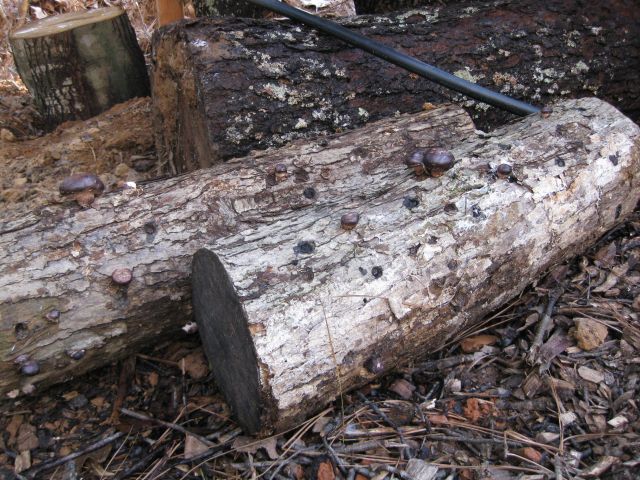
To ensure the logs in the shelter are well watered I rigged a simple spraying system which is gravity fed by rainwater harvested by the tractor building.
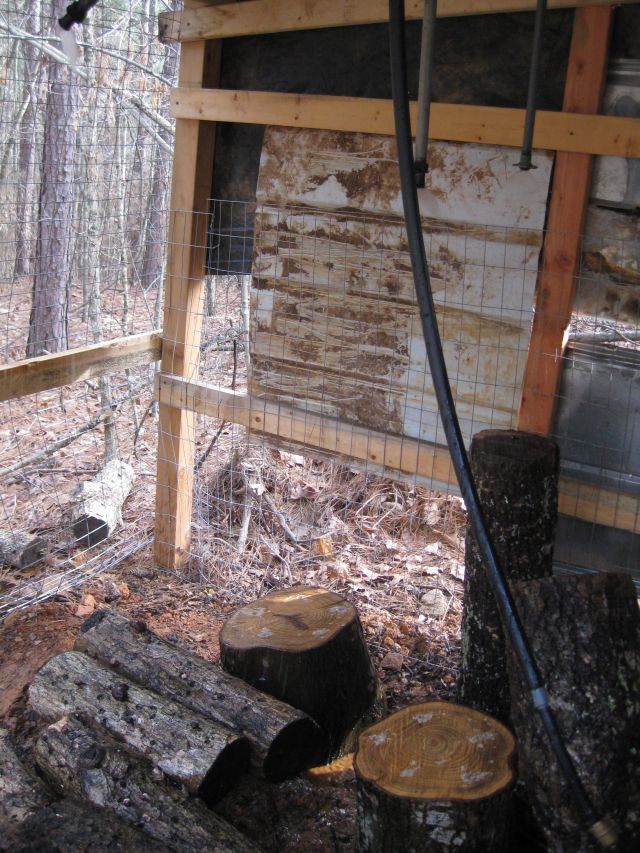
The mushroom shelter is close to the path I use for my woodland walks with Trudy (my canine companion) so I pass it frequently and will be more likely to keep a close eye on mushroom happenings than when the growing took place in the valley which was out of the way. Also, to deter wildlife visitors I have completely enclosed the 8ft by 8ft structure. The 4″ posts are cedar, the 2×4’s are untreated wood, the scraps of metal are just scraps, the black material was used to prevent silt erosion on a construction site, and the fencing material was left overs from a chicken paddock. And the red door, which is not an exterior door and will deteriorate from weather exposure, is a $2 special from the thrift store. Not a particularly attractive construction but should not attract human attention (unless passersby think there is a still in operation) and hopefully will provide food for the table.
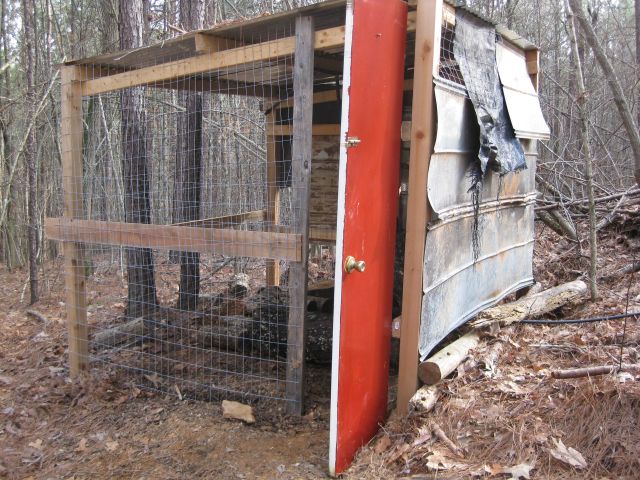

Any thoughts on trying to naturalize mushrooms in your woods? You might be interested in this – http://alanbishop.proboards.com/index.cgi?board=alt&action=display&thread=5995 and the forum in general. Some very knowledgeable folks, all of whom are generous and civil which is an net rarity.
Regards,
Mike
Mike,
Good link – thanks. My thoughts are to use the oyster grain spawn on the new woodchips I received from my neighbor. I know oyster is robust and should be able to take care of itself. More adventurously, when my shiitake mature I will try cultivate them on petri dishes with agar in a glove box I am constructing, and then try grow them on birch dowels and then plug them into oaks.
Regards,
Richard
I’ve recently been successful growing oyster mushrooms (pleurotus ostreatus) on wild cherry. It’s less picky than shiitake, and I figure the density of the wood will help with moisture retention and lengthen the life of the log. I inoculated last spring and just harvested my first flush!
Congratulations with your success with wild cherry. I think, with hindsight, that my constructed mushroom shelter was a bad idea and that I should have left the logs in a shaded open area. As I learned with my chicken coop, rodents can access any area and if they wanted to nibble a mushroom they could have done so more easily in the shelter. I recently acquired a number of sound oak logs and will be trying shiitake again, but this time in the open.